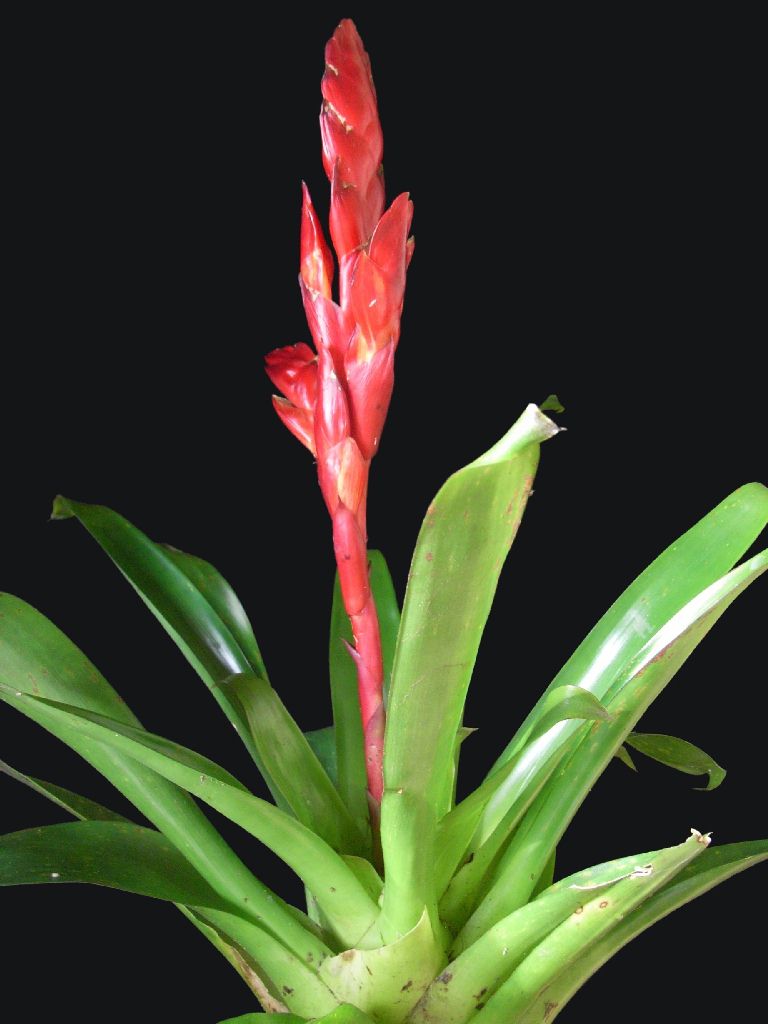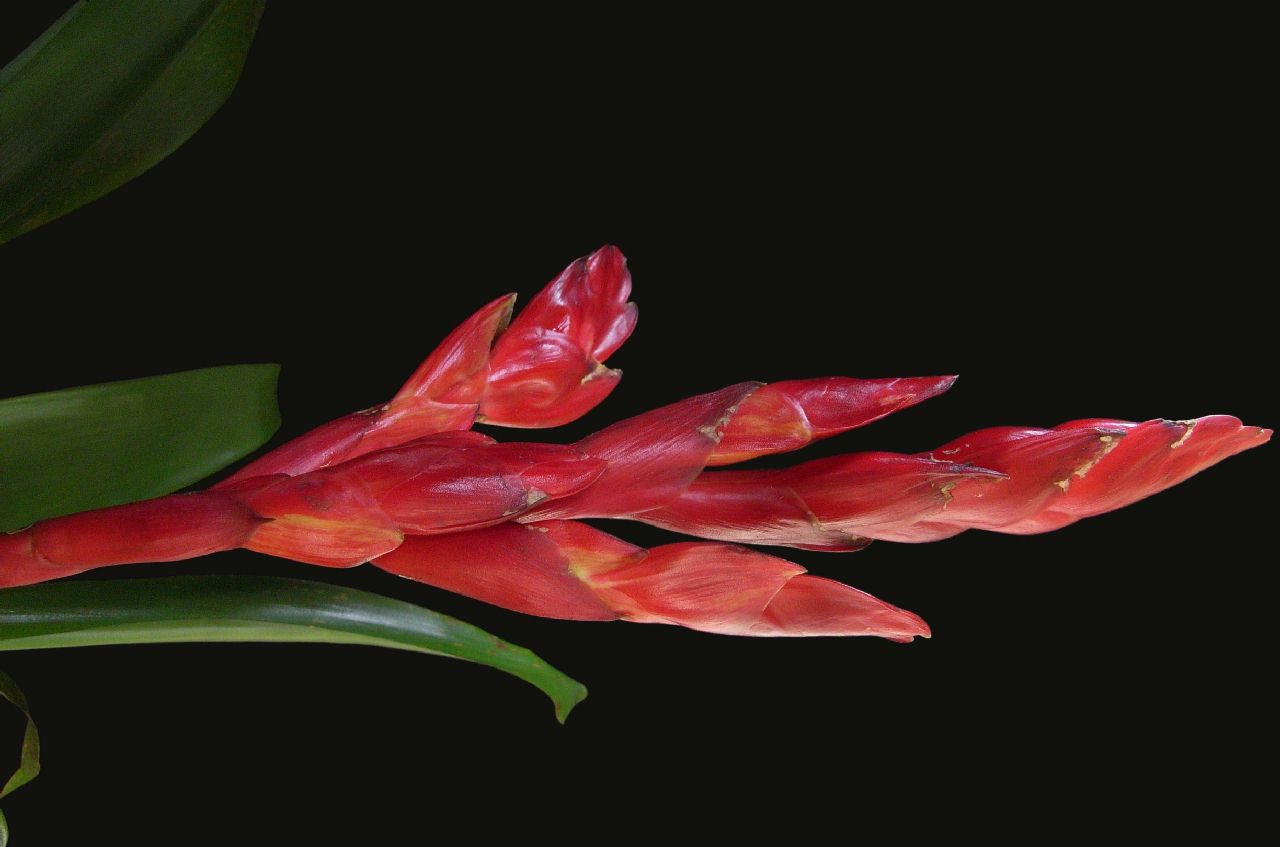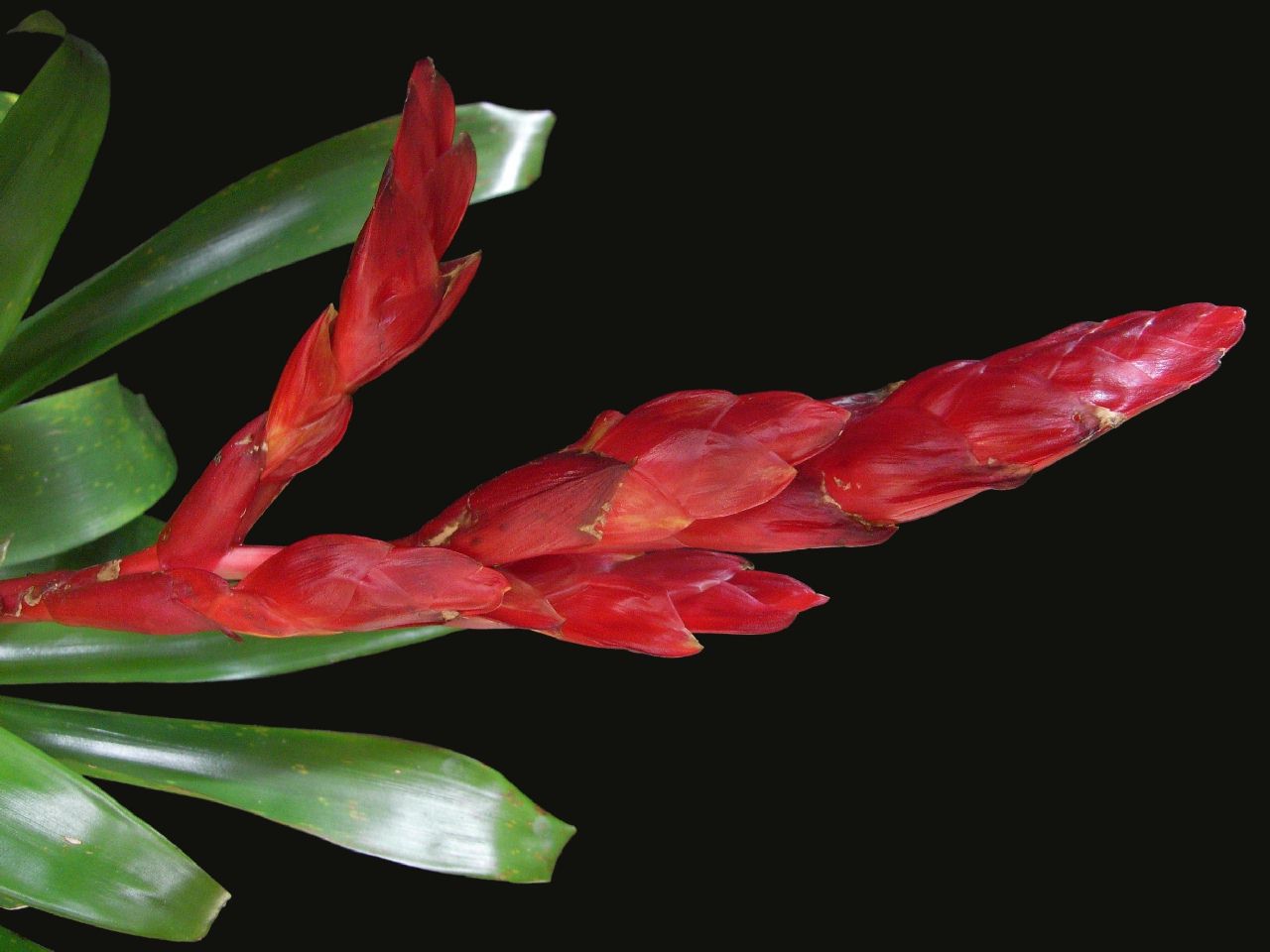Sold as Vr. Pulmorata or Pulmonata. I can find no evidence of either name, but in light of the follow the article, I believe plants in circulation in Sydney are probably 'Poelmanii' or a cultivar of it and should be re-labelled as such.



This plant from the very old Sydney collection of Mrs Joyce Thomas. Probably imported by Joyce.
Sold as Vr. Pulmorata or Pulmonata. I can find no evidence of either name, but in light of the follow
the article, I believe plants in circulation in Sydney are probably 'Poelmanii' or a cultivar of it and should be re-labelled as such.



Vr. ‘Poelmanii’ in Monographie des Bromeliacees – Tillandsiees, by C Ch. Chevalier, p23, 1930.
Signalons encore le V. x Poelmanii (V. x gloriosa x Van Geertii) dont ; l’epi, plutot petit, oblong, pointu, montre l'influence de ce dernier. Sous le nom de Poelmanii, on cultive a Gand une forme beaucoup plus vigoureuse et plus coloree, caracterisee par la faculte de donner naissance a de nombreux rejets, ce qui en facilite la propagation.
Translation
Let us introduce again Vr. X Poelmanii (Vr. x gloriosa x Van Geertii) of which; the spike is rather small, oblong, pointed, showing the influence of the latter. Under the name of Poelmanii, it is cultivated in Ghent with a more vigorous shape and more colorful, characterized by the ease with which it gives offsets, that facilitates the propagation of it.
From J. Brom. Soc 39(1): 30. 1989 based on Dutrie 1945
Single spike
Vr. poelmanii Duval (Vr. gloriosa x Vr. Van Geertii). Very much cultivated; medium-sized plant, strong spike, bracts bright red.
Vriesea ‘Poelmanii’ (‘Van Geertii’ x ‘’Gloriosa’)
From Chevalier in Brom. Soc. Bull. 1(3): 21. 1951
Vr. incurvata Gaud., Vr. Duvalii Morr, and Vr. Van Geertii Hort. Duval all contributed to certain Vriesia hybrids which are easily recognized by their incurving bracts, and by the shape of their spikes which are oblong, more bulging, and thicker.
Principally to be noted are: V. X gloriosa Duval (V. Barilletii X V. incurvata) and its offspring: V. X Poelmanii Hort. (V. X gloriosa X Van Geertii), a medium sized plant with stout spike, and enveloping bright-red bracts, widely cultivated in Ghent. Particularly notable among second-generation hybrids are V. X Menelik Hort. Leod., with bracts of a violet-red, almost black; V. X Wallonia Hort. Leod., a vigorous plant with a spike 45 centimeters in length, and red bracts shaded with yellow.
ON THE ORIGIN OF A VRIESEA HYBRID (Vriesea x Van ackeri Hort.) by Charles Chevalier in J. Brom. Soc. 11(4); 60. 1961
The Bromeliad Society Bulletin published on the cover page (Vol. IV, No. 3, May-June, 1954) a photo of a Vriesea hybrid with a beautiful branched flower stalk, that Mr. Walter Richter had sent to Mr. Mulford Foster, under the name of Vriesea X flammea Hort.)
My long experience with Bromeliads in general, and with Vrieseas in particular permits me to express some doubt about the basis for the naming of the Vriesea represented by the photo in question.
The true V. X flammea, obtained by Duval from crossing of V. X van geertii Duval with V. (Encholirion) jonghei Morr, was presented at a meeting of the Societe Nationale d'Horticulture de France on December 12, 1901, but it was not described nor illustrated. Beyond doubt, this hybrid does not correspond with the photo presented. I am all the more confirmed in my opinion upon reading in the accompanying note, "It is a remarkable complex hybrid containing the blood of at least seven different species and hybrids ... The branched characteristic probably comes from V. rodigasiana, one of its parents. "There is therefore an error; it is evident that this paragraph does not apply to V. X flammea of Duval which is a primary hybrid.
To what hybrid, then, does the photo in question correspond? An examination of the spike, thick, with bulging imbricated bracts, incurving at the top, gives evidence that V. incurvata Gaud. or one of its derivatives: V. X van geertii Duval, or, better perhaps V X poelmanii Hort. have largely participated in its creation.
M. Ernest De Coster, member of the Bromeliad Society and grower of Bromeliads on a large scale in Ghent, whom I questioned on this subject replied that the plant pictured on the cover must, in his opinion, be V X van ackeri Hort. He agreed at the time to seek out the information at the source, and, aided by M. and Mme. Wery-Van Acker, successors to M. J. Van Acker-Algoet, I obtained a fund of information, hitherto little known, which clears up, in a certain measure, the origin of this hybrid.
About 1887-1888, M. L. Poelman, father-in-law of M. J. Van Acker, bought at Duval's in Paris a hybrid Vriesea with the authorization from him to give it his name. It was V. X poelmanii, which came from the crossing of V. X gloriosa Duval with V. X Van geertii Duval. The first comes from V. barilletti Morr. fertilized by V. incurvata Gaud. The origin of the second is not known for sure, but it seems, from the form of the spike, that V. incurvata Gaud. was not a stranger to its creation.
Beginning with 1899, after the revival of the establishment of his father-in-law, M. J. Van Acker made numerous crossings and propagations from seed. Unfortunately, his notes, which his daughter had the kindness to send me, gave no precise indication on the subject of the species employed. It is certain, nevertheless, that V. X poelmanii Hort. is the original element of it. However it may be, in 1930, at the Centennial Exposition in Ghent, he presented an important lot of Vrieseas with branched flower stalks; to this beautiful subject he gave the name of V. X van ackeri Hort.
The birth of this hybrid is then, in a certain measure, well established, but which is the species with the branching stalk that was associated with V. X poelmanii? I say intentionally "branched inflorescence" for I know of no example of the crossing of two species with single stalk which gave directly one that was branched. This opinion is shared by M. L. Dutrie (see Bull. Hort. April 1st , 1947, page 118.)
I rule out, directly, V. philippo-coburgii Wawra, a very rare species, and seldom floriferous, and the large species: V. hieroglyphica Morr., V. tessellata Morr., V. glazioviana Lem. (V. reginae Beer) which, at that time, interested few of the horticulturists practising hybridization. I do not believe that one can invoke the participation of V. saundersii Morr, it presents the peculiarity of a strongly drooping floral stem and it transmits this fault to its descendants: V. X kitteliana Wittm. (V. barilletii X V. saundersii) etc.
One can admit V. rodigasiana Morr. with branched flower stem with short, spaced bracts on a slender, upright stalk, and also its off-spring: V. X vigeri Duval already cultivated at that time and which the notes of M. J. Van Acker point out as having been utilized in some hybridizations.
To these names one should add that of V. procera Mart. (V. gracilis Gaud.) introduced in 1886. I do not know this species, not widely distributed, but M. L. Dutrie in his report on the Bromeliaceae (Bull. Hort., June 1st, 1947, page 117) points out a V. procera bicolor Hort. which he believes to be the off-spring of V. X kitteliana X V. brachystachys major.
To take up again the possibility of an intervention, whether it be from V. rodigasiana Morr. or from V. X vigeri Duval, it must be admitted that only the branching characteristic has acted and it is V. incurvata Morr. frankly dominant, that has imposed the characteristic form upon its spike. It is noted that, about 1910, M. J. Van Acker mentioned V. X vigeri but said nothing of V. rodigasiana. V. X vigeri is an elegant little plant created by Duval about 1900 by the crossing of V. rodigasiana by V. X cardinalis Duv. (V. carinata X Krameri); it has a slender upright flower stem with branched inflorescence having spaced cardinal-red bracts.
It is also certain that as a result of the seedlings and crossings resulting from the intelligent selection of the most beautiful specimens of V. X van ackeri (also known under the name of V. poelmanii (branched)) there has been a great improvement in its coloration, in its form and in its inflorescence: stalk more branched, spike larger and broader, well-filled, without spaces between the bracts. Besides V. X van ackeri Hort. there originated at Ghent, and at about the same time, another Vriesia hybrid, cultivated for some time at Ghent on a large scale, under the improper name of V. X viminalis-rex or V. viminalis erecta.
What is the plant cultivated under this name, about 1910, in Ghent? I do not know. I doubt strongly that the true V. viminalis Morr. had anything to do with its creation. This species, so seldom cultivated because so slightly ornamental, is recognized by its single, narrow, fusiform spike with green bracts at the top of a long, slender stalk, often bent. (Belg. Hort. 1878, pl. color, page 257.) This name appeared for the first time in the notes of M. J. Van Acker in 1920; One reads there, "V. viminalis comes from crossing of V. x van geertii, strong plant, single spike, thin and long. Has been fertilized by different varieties. I have obtained some remarkable specimens, among which, in 1928, there was a V. X viminalis (branched), a very strong plant, endowed with a remarkable spike". Much later, in the years 1933 to 1937, M. J. Van Acker announced that he had made a number of crossings, notably between V. X viminalis (branched) and V. X rex (V. morreno-brilletti X cardinalis), between V. X viminalis-rex and V. X poelmannii (branched) (V. X van ackeri, etc.) In 1937 he produced V. X vigeri Duval.
There resulted from all these crossings and others of the same kind, performed by various horticulturists of Ghent, the two groups of branched Vrieseas originated there. Very similar to one another, having many parents in common, they differed among themselves in such details as only specialists could detect. In spite of the fact that V. X van ackerii is the oldest, the horticulturist of Ghent still use the name of V. X viminalis-rex to designate all these branched Vrieseas.
According to M. Ernest De Coster, the flower stalk of V. X van ackerii is well branched; the spikes better filled and without spacing between the bracts, showing the dominant, persistent action of V. incurvata. The spikes are noticeably broader and larger than those of V. X viminalis-rex among which the influence of V. X rex and its forebears seems to remain deep-rooted. The plants are also more uniform, their characteristics perpetuate themselves more faithfully seed. Among V. X viminalis-rex, one finds in the seedlings several different types, with the leaves more pointed, and less broad, with the spikes narrower, and, at times, even the flowers plainly isolated from their neighbors, showing thus an atavistic return to certain of its ancestors: V. carinata Wawra (V. brachystachys Morr.) etc.
These two hybrids, which, practically, are only one, are then the complex hybrids of which we know the relationship. It remains, however, to determine with certainty the species which has supplied the branched characteristic. For my part, I should be pleased to know the origin of the plant known under the name of V. viminalis.
I hope that these blanks can be filled in. I shall receive with gratitude all information sent in.
Translated by Frank H. Overton, 1348 Winchester Ave., Glendale, Calif.
It can be seen that up till 1961 V. ‘Poelmanii’ was considered to have a single inflorescence but as pointed out by Chevalier much ‘secret’ hybridising was taking place.
The first reference I can find of this is in J. Brom. Soc. 22:103. 1972 where Kent mentions a Vriesea Poelmanii Variegata. An error seems to have been made in the Bromeliad Cultivar Register because it is quoted as Vr. ‘Poelmanii-Selecta’. I will be correcting this error. Undoubtedly this variegated plant has links with ‘Madame Carlos Broeckart’ and thus to ‘White Line’ which has a compound inflorescence. To my mind it is not a cultivar of ‘Poelmanii’ but does have links.
The next reference is in Kent’s 1979 Catalogue where he offers V. ‘Poelmanii Super Select’ (branched spike). Giving a name such as this indicates that seed raising was involved and under the current rules this sort of naming would be frowned upon even as a Nurseryman’s name. Remember we are dealing with hybrids not species! While I do not like the name ‘Super Select’ there is no Vriesea cultivar by this name and I will use it in the Register linking it to the true V. ‘Poelmanii’ but not a cultivar of it and also the probable linking with ‘Van Ackeri’. V. ‘Poelmanii’ will be shown as a simple inflorescence as first named by Duval in 1896 or was it M L Poelman in 1888?
Finally you are referred to the Poelmanii Cultivar group which on the Cultivar data base on http://bsi.org will reveal 15 current names. This means the plants look like the cultivar ‘Poelmanii’ but are not necessarily linked and include both simple and branched forms.
I would like to thank Leo Dijkgraaf of the Netherlands in helping me in my research.
Not being able to find 'pulmonata' in the binomial listings I Googled and found two references--one yours and the other from the Caloosahatchee Meristem of April 2010, which included a cover picture [featuring V. pulmonata--or V. 'Pulmonata']of Dr. Lou Wilson's book, Bromeliads for Modern Living and the following note:
"Front cover of Dr. Lou Wilson’s book, first printed in 1977. There were very few commercial vriesea hybrids at that time so suspect that the cover photo is of Vriesea pulmonata seen elsewhere in the book."
I think that in those early days of our Society, the artist possibly just copied the picture she found on the cover and so it was labelled 'pulmonata' but I'll note the change and hope that you might find this reference of some interest.